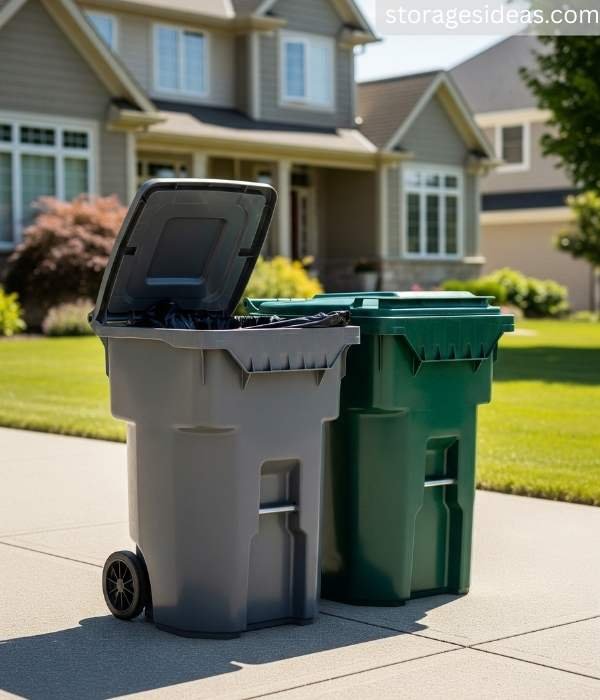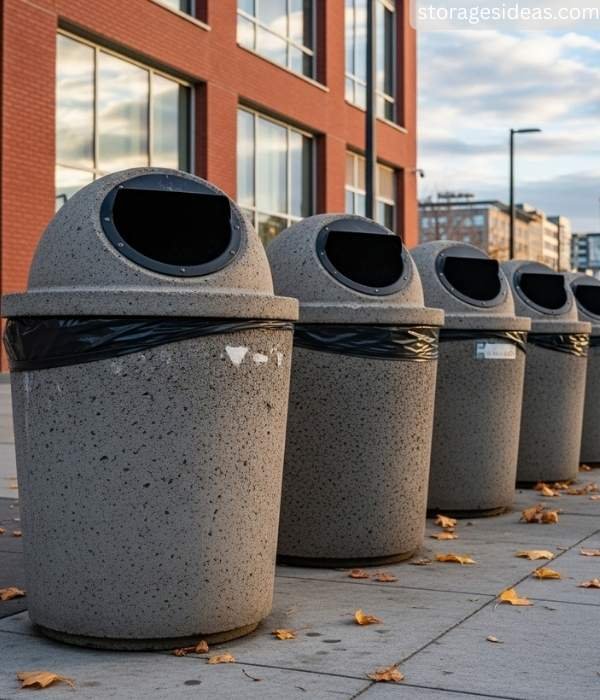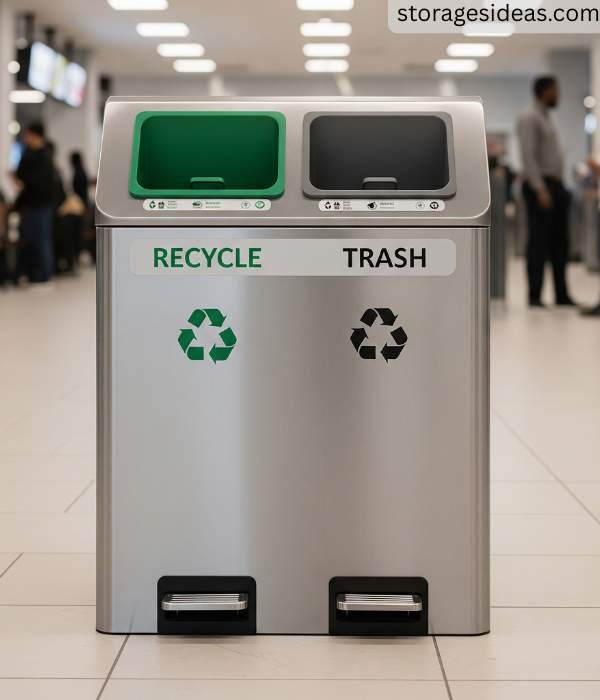I used to think picking up an outdoor garbage can was simple. Walk into a store, grab a bin, done. Not even close. My first backyard bin cracked in winter, and the office bin toppled over during a gusty day. Later, raccoons discovered my trash, scattering garbage across the lawn. Cleaning it took hours, and the smell lingered. I learned the hard way that a proper outdoor garbage can is not just a container—it’s a critical tool for cleanliness, order, and convenience.
In this guide, I’ll walk you through everything I’ve learned over the years, including practical tips, personal anecdotes, and detailed bin recommendations for home, office, and public spaces.
You’ll learn about:
- Features that make a container durable
- How to choose the right size and material
- Strategic placement for maximum use
- Design and style considerations
- Types of bins and their ideal applications
- Installation and setup tips
- Maintenance hacks and seasonal care
- Common mistakes to avoid
- FAQs covering unique scenarios
By the end, you’ll be confident selecting the perfect outdoor garbage can for your needs.
In This Guide, I’ll Cover
Toggle1. Durability – The First Non-Negotiable Factor
Durability is the foundation of a good outdoor bin. A weak outdoor garbage can becomes a recurring expense and a hygiene issue. I’ve had bins that cracked in winter, bent under heavy loads, or rusted after a rainy season.
Materials
- Plastic (HDPE/Polypropylene): Lightweight, rust-proof, and affordable. UV-stabilized plastic prevents cracking in the sun. Thin plastic may crack in cold temperatures, so always check the thickness.
- Steel/Metal: Ideal for high-traffic areas. Powder-coated steel resists corrosion, can handle heavy items, and is fire-resistant. Untreated steel will rust quickly, especially in humid climates.
- Concrete: Extremely heavy and permanent, perfect for public spaces, parks, and vandal-prone zones. Lasts for decades, but once placed, cannot be moved.
Other Durability Considerations
- Lid Type: Hinged or locking lids prevent animals from tipping the bin and reduce wind-related messes.
- Weight & Stability: Heavy bins resist tipping; lightweight bins may need stakes or weighted bases.
- Weatherproofing: Rainwater, snow, and sun can degrade materials. Ensure proper drainage and UV protection.
Pro Tips:
- For home use, lightweight bins work if shaded and sheltered.
- For commercial/public spaces, invest in steel or concrete to avoid frequent replacements.
- Animal-proof bins significantly reduce cleanup time.
2. Placement – The Secret to High Usage
Even the best bin can fail if poorly placed. Placement is about accessibility, visibility, and convenience.
Key Considerations
- High-Traffic Areas: Entrances, exits, and walkways ensure the bin gets used.
- Seating Zones: Place near patios, benches, or office break areas.
- Multiple Bins: Several small bins prevent overflow better than one large bin.
- Accessibility: Consider children, the elderly, and wheelchair users—place bins at reachable heights.
- Visibility: Bins should be noticeable without being obstructive. Hidden bins are less likely to be used.
Examples from My Experience:
- A bin at a corner of my garden went unused—moving it along the main patio path doubled its usage.
- In my office, placing bins near coffee machines and vending areas reduced litter on the floors.
Extra Tips:
- Avoid placing bins near storm drains—overflow can create environmental hazards.
- Shade bins where possible to prevent odors from intensifying in summer.
- Ensure the area around the bin is clean and clear; clutter discourages use.
3. Style and Design
Looks matter more than I initially thought. People are more likely to use a bin if it blends with its surroundings.
Home Placement
- Neutral tones, wood finishes, or modern designs blend with patios, gardens, or decks.
- Bright colors or labeled bins help children or guests separate recyclables.
- Compost bins with a natural look encourage correct usage.
Business/Public Spaces
- Sleek metal or concrete bins convey professionalism and reduce complaints about odor or mess.
- Covered bins prevent animals from entering and reduce litter spread.
- Matching bins with seating areas, signage, or landscaping improves aesthetics and encourages use.
Pro Tip: I installed a wood-finish plastic bin in my backyard. It looks like part of the furniture, and guests always use it without being reminded.
4. Understanding the Types of Waste Containers
Choosing the right type of bin is critical. It depends on usage, location, and waste type.
Plastic Bins

- Use: Household trash, garden clippings, lightweight office trash.
- Locations: Patios, balconies, backyards, low-traffic offices
- Pros: Affordable, rust-proof, lightweight, easy to clean
- Cons: Can crack under extreme weather, may fade in the sun, and is less secure against animals
- Tips:
- UV-stabilized plastic extends lifespan.
- Use snug-fitting lids to reduce pests and odor.
- Add removable liners for hygiene and easy disposal.
- UV-stabilized plastic extends lifespan.
- Practical Example: I use a 32-gallon HDPE bin for garden waste. It survives summer heat and winters without cracking, and the removable liner makes disposal fast.
Steel/Metal Bins

- Use: Heavy office or commercial waste, packaging, recyclable items.s
- Locations: Office entrances, schools, parks, urban sidewalks
- Pros: Durable, fire-resistant, professional appearance
- Cons: Heavy, can rust if untreated, difficult to move
- Tips:
- Powder-coated steel prevents rust.
- Locking lids deters animals and reduces wind spillage.
- Clean monthly to prevent the buildup of grime and odors
- Powder-coated steel prevents rust.
- Practical Example: The steel bin at my office entrance survives heavy use from hundreds of visitors daily and still looks pristine after 3 years.
Concrete Bins

- Use: Public spaces, vandal-prone areas, high-traffic zones.
- Locations: Plazas, playgrounds, parks
- Pros: Extremely sturdy, fireproof, vandal-proof, long-lasting
- Cons: Heavy, permanent, expensive
- Tips:
- Place near benches or entrances for maximum convenience
- Combine with ashtrays or recycling if needed.
- Ensure proper drainage to prevent water pooling.
- Place near benches or entrances for maximum convenience
- Practical Example: The concrete bins in my community park survive storms, floods, and accidental knocks without any damage.
Hybrid and Specialty Models

- Hybrid Bins: Dual compartments, stylish exteriors, used for residential or upscale areas.
- Animal-Proof Bins: Secure lids, ideal for food or compost.
- Recycling Stations: Color-coded, labeled compartments for paper, plastics, and metals.
- Foot-Pedal Bins: Hands-free operation for hygiene.
- Tips:
- Use dual compartments for recyclables to encourage sorting.
- For compost bins, place them away from seating and children’s play areas.
- Foot-pedal or sensor-operated bins improve hygiene in kitchens or offices.
- Use dual compartments for recyclables to encourage sorting.
5. Size Considerations
Choosing the right size is often overlooked but critical. An oversized bin can discourage use, while a small bin overflows quickly.
- Small Bins (10–20 gallons): Suitable for patios, balconies, and light household use.
- Medium Bins (20–35 gallons): Great for gardens, home offices, or small commercial areas.
- Large Bins (50+ gallons): Ideal for public spaces, event venues, or high-traffic offices.
- Multiple Small Bins vs. One Large Bin: I prefer several small bins placed strategically; they’re easier to empty and reduce overflow.
- Practical Example: For my backyard party setup, I place 3 small bins in corners rather than one huge bin, reducing litter spread significantly.
Extra Tips:
- Estimate your daily or weekly waste generation
- Consider seasonal spikes (holidays, parties, events)
- Don’t forget the capacity for recyclables if using separate compartments.
6. Installation & Setup
Proper installation ensures safety, hygiene, and long-term usability.
Key Considerations
- Surface Stability: Place heavy bins on flat, level surfaces. Light bins may need stakes or a weighted base.
- Accessibility: Ensure all users (children, the elderly, differently-abled) can reach the lid easily.
- Liner Placement: Removable liners speed up emptying and cleaning.
- Labeling: Clear signage improves proper use of recycling or dual-compartment bins.
Placement Tips
- Avoid direct sunlight for plastic bins to prevent warping.
- Place bins near waste generation points: kitchen doors, patios, office coffee stations
- For public spaces, group bins for recyclables, compost, and general waste together
Safety Tips
- Anchor large bins in windy areas to prevent tipping.
- Check that lids open easily but stay closed against wind and animals.
- Use gloves when installing bins to prevent scratches or injury.
Practical Example: Installing a hybrid bin near my outdoor kitchen improved recycling compliance and made food disposal hygienic and fast.
7. Common Mistakes
I’ve learned the hard way that picking the wrong bin or using it incorrectly causes unnecessary problems.
- Buying Cheap Replacements: False economy. Poor quality leads to frequent replacement.
- Skipping Lids: Increases odors, attracts pests, and causes wind-related messes.
- Poor Placement: If users can’t reach or see the bin, they won’t use it.
- Incorrect Size: Too small leads to overflow; too big may feel cumbersome.
- Ignoring Maintenance: Dirt, stains, odors, and pests accumulate quickly without regular cleaning.
- Using One Bin Type for All Needs: Plastic for heavy waste or concrete for tiny spaces leads to inefficiency.
Pro Tips:
- Match the bin type to its primary use
- Plan placement before purchasing
- Invest in quality for long-term durability.
8. Maintenance Hacks
Proper maintenance keeps bins clean, odor-free, and long-lasting.
Weekly Maintenance
- Empty liners before tearing
- Rinse interiors with mild soap and water.
- Wipe lids and handles to reduce bacteria.
Monthly Maintenance
- Inspect for cracks, rust, and misaligned lids.
- Check concrete bins for moss or algae.
- Touch up paint on steel bins if needed.
Seasonal Adjustments
- Summer: rinse often, provide shade, sprinkle baking soda to control odors.
- Winter: inspect plastic bins for cracks, and prevent ice accumulation on lids.
- Rainy Season: Ensure drainage holes prevent water pooling.
Tips for All Bin Types
- Use removable liners for hygiene.
- Color-code recycling bins for ease of use
- Foot-pedal or motion-sensor bins reduce direct contact.
- Use vinegar or baking soda for natural odor control.
- Label bins clearly to encourage proper disposal.
Practical Example: In my office, monthly inspections and weekly rinsing of bins prevent odor and maintain a professional appearance.
9. Final Thoughts
A well-chosen outdoor garbage can transforms your space. It reduces clutter, encourages proper disposal, minimizes pests, and enhances aesthetic appeal. My rule: durability, ease of maintenance, placement, style, and size matter most.
With the right bin, waste management becomes seamless, whether at home, in an office, or in a public park. A small investment in the right bin saves time, frustration, and keeps your environment clean.
10. FAQs
Q1: How often should I empty my outdoor garbage can?
A: Home: weekly; High-traffic business/public: daily or twice daily
Q2: Can plastic bins handle heavy waste?
A: Only light to medium waste. Steel/concrete is better for heavy-duty use.
Q3: How can I prevent animals from accessing my bin?
A: Use animal-proof bins, lock lids, and educate users.
Q4: Can bins be placed on uneven surfaces?
A: Yes, anchor lightweight bins; concrete bins are naturally stable.
Q5: Which bin is best for recycling?
A: Multi-compartment stations, clearly labeled and color-coded.
Q6: Do outdoor bins need covers?
A: Yes, it prevents odor, rainwater, and pest access.
Q7: How do I maintain steel or concrete bins?
A: Steel: monthly wipe; Concrete: occasional pressure wash, inspect for cracks.
Q8: How do I choose the right bin size?
A: Estimate daily waste and foot traffic. Multiple small bins often outperform one massive bin.
Q9: Can one bin type work everywhere?
A: No. Plastic for light use, steel/concrete for heavy-duty, specialty bins for compost or recycling.
Q10: How do I maintain bins year-round?
A: Rinse weekly, inspect monthly, secure lids, replace liners, adjust frequency seasonally.

